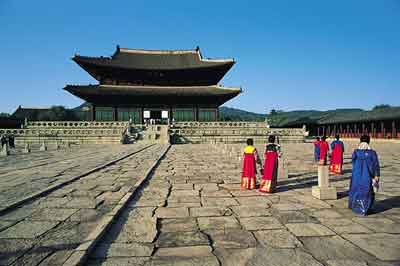
Glistening lines of kimchee pots sit above a natural spring, where hikers often refresh themselves
Article & photo by Julie Nariman
In my first month living in South Korea, the only hiking I did was on concrete. However, after I ventured out of the city and began exploring the mountains and countryside, I realized I had been missing out. I wasn’t just hiking up mountains; I was eating watermelon with a group of old ladies, photographing temple paintings, and finding a stone Buddha on a side trail. Hiking was fun, but its side diversions were marvelous.
Some of the loveliest hikes are the smaller provincial and county parks, like Muryeong Valley and Daedunsan. If you want a more intense hike, though, there are plenty. Jirisan is a huge, multi-day trek with breathtaking scenery and mountain huts where you can stay overnight (see below). On the other hand, Gyeongju’s Nam-San is a midget at 494 meters (1,600 feet). But this small mountain, with its 87 ancient Buddha figures, is the most interesting museum I’ve ever seen. Imagine grabbing a rope and swinging down a large rock to see an 800-year-old stone Buddha.
One of the best places to begin your hike is at a temple, which is often built on or near the base of a mountain. You are free to walk around and enjoy the ancient pagodas and Buddha sculptures. Monks are usually friendly and willing to answer your questions if either one of you speaks the other’s language.
On all mountains, ajumas and ajashis—middle-aged men and women—speed-walk in high tech hiking gear. On smaller mountains, they actually pump iron at workout centers on the summits. The same intense hikers will stop at a mountain spring to savor the cold water and then carefully place the communal drinking ladle back on its hook.
Koreans take hiking seriously, but they also enjoy it. The mountains themselves have clean trails, thudding waterfalls, and thoughtfully-named features like “Rice Steamer Rock” and “Three Fairies Pond.” Also, some of the best eating in Korea is near the mountains. Specialties are handmade tofu (“son-dubu”), whole duck or whole chicken soup (“O-ri bek su,” “Bek su”), mountain vegetables over rice (“san-che-bi-bim-bap”), and a grilled mountain root that’s tastier than it sounds (“do-dok-goo-ee”). Even with all the good food, Koreans still pack a picnic and will probably share with you if you’re alone. When I hiked Jirisan, I was offered red peppers, plums, coffee, kimbap (rice and vegetables wrapped in seaweed), kimchee, and frozen watermelon.
Certain things can make your trip easier. You should know a few basic phrases in Korean, and definitely learn hangul, the Korean alphabet. It takes most people less than a week to learn and is necessary for map-reading and directions. And definitely use a map. At most national and provincial parks, you can get one at the entrance for free or for 1,000 won ($1). Also, dress like you’re hiking. Don’t wear sweatpants that look like pajamas or jeans with holes. The more you look like you’re supposed to be hiking, the less Koreans will worry about you or, worse, glare at you. If you’re alone, you might get adopted anyway; most Koreans find it strange when people hike alone, especially women. At the Youngnam Alps, a family I met on the trail offered me chocolate and then informed me—quite firmly—that I would be hiking with them.
That evening, I enjoyed a delicious raw fish dinner with their extended family, and later slept soundly in their 10-year-old son’s room.
Public transportation in Korea is excellent, with frequent and inexpensive bus and train service. Lodging is also a bargain, at 20,000 won to 50,000 won ($20 to $50) per night. Yeogwons are inexpensive motels where you can choose a room with a Western bed or floor-heated “ondol” room with thick mats and comforters you spread out on the floor. Many yeogwons are also “love motels,” but that shouldn’t be a deterrent—you’ll just get a free toothbrush and a condom. Minbaks are similar to yeogwons, but are actually attached to private homes, and sometimes have shared facilities, like kitchens or bathrooms.
Korea is a land of contrasts. A college girl might wobble up a trail in pink high heels, leaning on her boyfriend’s arm. But don’t snicker too loudly; on the next steep hill a bent old grandmother will blaze past you. Just say “annyong haseyo” (“hello”) and keep trudgi







 A perfect place to stay in the world is in the Pear of the Orient seas of Luzon, Visayas and Mindanao Philippines. The essence of paradise is the fragrance in every island you step. When you count to step island 1 to island 7,101 you might lost in the middle for over-joy and satisfaction of the friendly nature Philippines.
A perfect place to stay in the world is in the Pear of the Orient seas of Luzon, Visayas and Mindanao Philippines. The essence of paradise is the fragrance in every island you step. When you count to step island 1 to island 7,101 you might lost in the middle for over-joy and satisfaction of the friendly nature Philippines. 